
Peru: Sacred Valley
As a botanist’s daughter, the number of times I heard the word ‘biodiversity’ while growing up is probably what led to my fascination with South America, home to the Amazon rainforest. In the recent years, watching David Attenborough’s shows has only intensified my thirst for nature. A trip down there to experience the forest at its most prolific was sure to drain my pockets in no time. Instead, I decided to get a sneak peek into this continent visiting Peru, home to Machu Picchu, one of the new seven wonders of the world.
It all started when one of my friends suggested the destination for our trip which did not happen. It was some five months ago, and I toyed with the idea of a solo trip since everybody I knew either did not want to take a few days off from work or were hesitant to commit to it so far in advance. The fact that Indian citizens with a valid US visa do not need a Peruvian tourist visa hastened my decision and the idea turned real when I booked those expensive flight tickets all the way to the city of Cusco, the ancient capital of the Incas.
Before I knew it, it was time to leave. I was nervous about my little to no Spanish abilities. It dawned on me only when I called a hostel I was going to stay at and the man at the other end did not speak anything but Spanish, forcing me to translate my request for a ride from the airport using Google translate. It did not help though, because he heard all I had to say, seemed to understand and broke into high speed Spanish which made absolutely no sense to me. I helplessly repeated “No entiendo” which means “I don’t get it”, but that did not make the situation any better and I had to hang up. A week full of circumstances like this would be interesting to say the least.
The words Peru and Lima seemed to find only one match in the attic of memories in my brain which was the chapter in an English textbook about Julianna Koepcke, who was discovered in the Amazon rainforest after she survived for 11 days after a plane crash. She was the lone survivor among those aboard that fateful flight from Lima to Pucallpa. While I wished for adventure and hers was a story that inspired me, I ardently hoped nothing like that ever happened to me on my travels.
I had planned what I would do on most days of the trip already. While waiting for my 8-hour long flight to Lima from Los Angeles, I figured I could take a taxi tour on the first day and hurriedly booked it. I arrived in Lima just about midnight and had to wait for four hours for my next flight to Cusco. I was quite impressed that the taxi was waiting for me as i stepped outside the airport. It was rather cold, but I did not feel the need to wear more than one jacket. Our taxi dashed through the narrow streets of Cusco, a UNESCO designated world heritage site itself, on to the sacred valley. I stared out the windows at what seemed to me like a cleaner, much orderly version of rural India. There were not many people out and about that early in the morning.

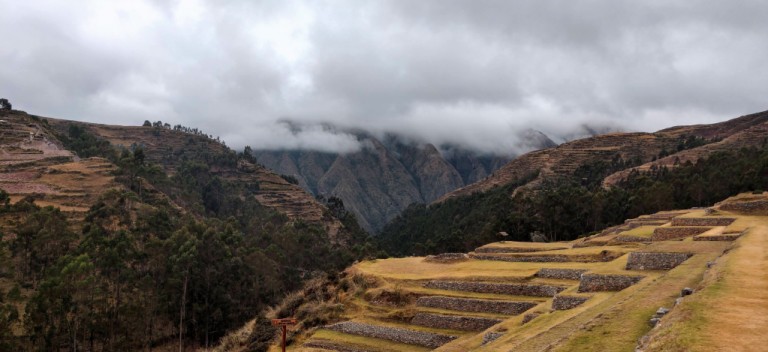
Our first stop was Chinchero, an Andean village about 30 km from Cusco. The locals in their colorful attire were setting up shop for the market that is held thrice a week as I walked up the stairs to explore the ruins. I was too early to be able to take a look at the supposedly stunning interiors of the church built upon the foundation of an Inca temple. I sauntered up and down the terraces amid the mighty Andes. I read that the terraces were built to make the most efficient use of shallow soil and to make irrigation easier and that they are called ‘Andenes’. I would see lots and lots of them in the next few days. I later learnt that the government has plans of building an airport in Chinchero for the convenience of tourists who could fly so much closer to Machu Picchu at the risk of tarnishing the archaeological wonder that is the sacred valley. Famished, I walked back to the car and stopped for a coffee and a tasty empanada, glad that the street side vendor provided a vegetarian option. I dozed off as we drove to the Maras Salineras, the ancient salt mines. It was nothing short of a marvel to see some people at work scraping the dry salt from the rectangular pools in the mines constructed thousands of years ago, filled with water from a spring that was visible nearby. The Peruvian pink salt from Maras has many takers abroad, touted to have many health benefits due to a variety of minerals when compared to the regular table salt. Another half-hour drive brought us to Moray, our last stop before I would get dropped off. It was crowded and I could not help but overhear tourist guides explaining all about the Inca traditions and the terraces to their groups. The terraces here were unique that they were circular, reminding us of an amphitheater which made them all the more picturesque.

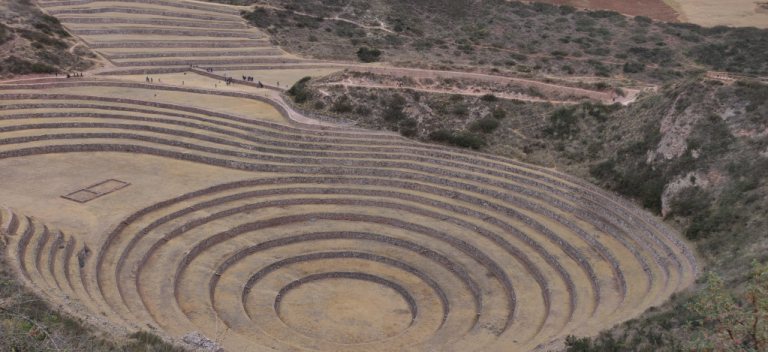
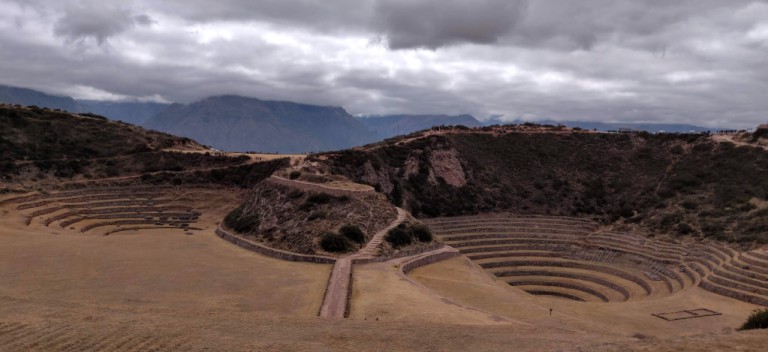
I was mostly asleep during the rest of our drive to the town of Ollantaytambo (took me a while to learn to say that right) where I would be staying, as the long walk around the terraces only made my exhaustion worse. Ollanta, as the locals call it, is a beautiful town in the valley that takes us on a journey to the past. I chose to stay here the first two nights of my trip as it seemed to have quite a few sites to explore and my train to the starting point of the 2-day Inca trail would stop here as well. I checked in at the hostel and was taken aback to see three beds in my room. I had originally booked a room for two people, hoping someone might join me later. After a nap, I walked into one of the restaurants nearby. They seemed to have a lot of pasta and the like on the menu to please tourists. Although I would describe traditional Peruvian food as something catering only to a non-vegetarian palette, the myriad dishes with quinoa and the abundance of corn and other vegetables and fruits made life quite easy for vegetarians too. I did not miss a chance to have fresh Marakuya (passion fruit) juice whenever I could. Cuy (Guinea pig) on the menu is something I would have never imagined as I was only familiar with it as a very cute pet in a lot of Hollywood movies, but is apparently the one dish you have to try while in Peru.
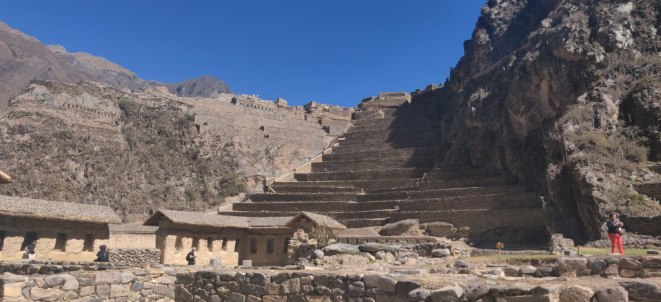
I spent the rest of the day in my room catching up on my sleep. I was ready early in the morning on Monday, rushing past kids going to school to visit the archaeological park, which I read is a testimony to the incredible engineering skills of the Incans much like Machu Picchu. I refused the services of many tourist guides at the entrance but realized it might have been better with a guide as there was no information anywhere about what we were looking at, except for their names. Maybe it was that way to help the guides make some money and was not any different at most tourist sites or it could be that there was little information available. On the other hand, having a guide would mean following their schedule and not having enough time to explore everything. I climbed up the steps along the steep terraces to see the Diez Hornacinas (ten niches), the Templo del Sol (Temple of the sun). The huge stones fitting tightly together without mortar is quite a sight to watch with awe! Time and again, researchers wonder how they were constructed so precisely. The military area of the fortress is a reminder of the Inca resistance to the Spanish invasion.

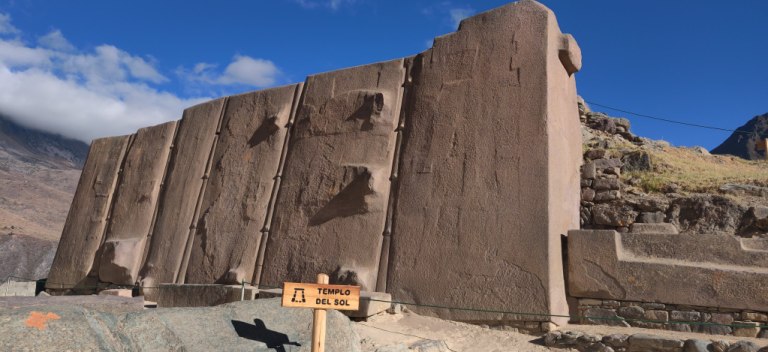

I saw a sign that said ‘Inka watana’ which was located rather high up and away from the rest of the spots and followed it to arrive at a stone structure after a steep climb. As I struggled to click some selfies with the gorgeous Andes and the valley in the backdrop, a man who appeared to be in his fifties appeared, greeted me with a big smile and offered to take my picture. Once I returned the favor, he started talking about what that place was used for in Spanish. He quickly realized I did not understand what he said and resorted to elaborate hand gestures. I thought he said something about cutting the stones and nothing else. Now was the chance to use Google translate in a real conversation! I whipped out my phone, opened the app and asked him to talk into it. He was perplexed but did it anyway. After introducing ourselves, I helped him download the app on his phone too. He was impressed and we spoke to each other about our travels. He is Argentine and was traveling from Patagonia. He was driving around since a month, stopping at any place he found beautiful. He had visited Machu Picchu the previous day and had no words to express how beautiful it is. He told me about his family and was surprised that I, someone like his daughter who was away studying, was traveling by myself. I reminded him how we started the conversation and he explained that this was a place used for torturing Incans who exhibited bad behavior. The stones have holes to which people were tied with ropes and left in the sun. I wanted to ask him how he knew this since I had tried searching and did not find any information online but held back since I thought that would be rude. He hugged me and bade goodbye with un beso (a kiss) on my right cheek. I thought he was treating me like family and felt special, but later learnt that it is the Argentinian way of greeting and saying goodbye, even if it is a stranger. Well, we were not strangers anymore!


I hurried after a while to take a look at the rest of the park and was back in town for lunch. The other major tourist attraction in Ollanta is the Pinkuylluna mountain granaries which is on the opposite side of the ruins, both visible from each other with the town in between. I would have missed the small entrance if not for a guide who thought he could talk me into paying him for an hour at the least. The hike up to the granaries was strenuous but not very long. The views of the town and the ruins were great. There were some more stone structures visible higher up the hill from the granaries, but the signs forbade us from going there. A fellow tourist suggested we ignore the sign and climb up together so that we could have each other’s back if something goes wrong. I immediately said yes, but we decided against it on the grounds that we were both in a different country and were not sure what the consequences of our action would be. I went back to the main plaza in the town and sat on a wooden bench, wondering what I should do for the rest of the day. It was around 3 PM. A quick Google search revealed a nearby historical landmark, the Pumarca ruins. It was about an hour and a half away by walk. I started walking in the direction of the ruins through the town and away from it by the river Patacancha. As the views turned more scenic, it got scarier. Google maps seemed to disregard the fact that I had to climb up and up and that it would take me much longer than what it said to get there. After an hour’s walk, somewhere amid the mountains, I decided to turn around as it got colder and I did not feel very well. I had an early dinner as I had to wake up by 4:30 to leave for Machu Picchu the next day.
To Be Continued…
Julianna Koepcke from the English textbook of Karnataka board brought nostalgic memories…
Interesting to read your adventurous trip. All the Best ! Enjoy.
Thanks uncle!
Nicely detailed Gargi 🙂
Thank you! 🙂